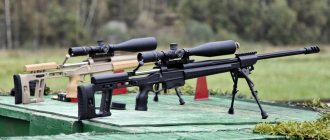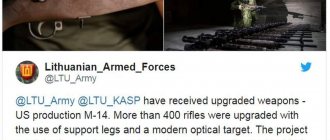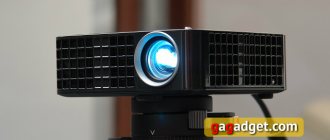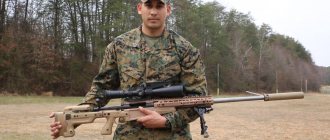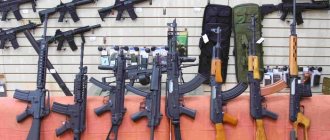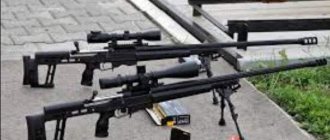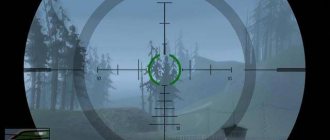Modern sniper rifles are specially designed precision killing weapons. Modern standards require that when shooting at a distance of 100 yards (about 93 meters), all 5 shots should be placed in a circle with a diameter of 1 inch (25.4 mm) or less, or that the accuracy should be no more than 1 arc minute. Of course, such weapons are expensive - on average 1500-3000 dollars, and even up to 9000 dollars (for example Heckler and Koch PSG-1)
Sniper rifle Steyr-Mannlicher SSG 04 (Austria)
The SSG 04 rifle (ScharfSchützen-Gewehr 04 - sniper rifle model 2004) was developed and produced since 2004 by the famous Austrian company Steyr-Mannlicher AG. It was created in addition to the very popular, but no longer very “fashionable” and “modern” rifle SSG 69 of the same company. The SSG04 rifle is based on the SBS 96 system, developed by Steyr-Mannlicher in the mid-1990s for a new line of hunting and sporting rifles. Currently, SSG 04 rifles are already in service with a number of security services and police forces in European countries. When using appropriate ammunition, SSG 04 rifles consistently provide accuracy of less than one arc minute at practical firing ranges.
The Steyr-Mannlicher SSG 04 sniper rifle has a longitudinally sliding rotary bolt with four lugs located in pairs in front of the bolt. High-precision barrels are made using cold rotational forging and are equipped with a muzzle brake. The trigger mechanism is adjustable, release without warning. The cartridges are fed from detachable box magazines. The rifle stock is made of impact-resistant polymer and has a height-adjustable butt comb and butt plate. The rifle does not have open sights; a Picatinny rail type guide is installed on the receiver, allowing for quick and accurate installation of any optical and night sights on the appropriate mounts.
Operating countries[edit]
- Austria - in service with the Austrian army and police special forces EKO Cobra.
- Argentina - in service with the Argentine army.
- Bolivia
- Germany - in service with German police units. Munich police were equipped with rifles during the 1972 Olympics bombing.
- Greece
- Israel - in service with YAMAM in the 1980s.
- India is armed with BSF and COBRA.
- Indonesia is in service with Kopaska.
- Jordan
- Ireland - in service with the ERU Army Rangers.
- Iceland
- China - used to a limited extent during the Sino-Vietnamese War (1979).
- Lebanon - in service with the Lebanese Armed Forces.
- Netherlands - Marine Corps.
- Pakistan - in service with the Pakistani army.
- Peru
- Poland
- Russia is armed with special forces.
- El Salvador - in service with the El Salvadoran police special forces.
- Saudi Arabia
- Singapore - in service with the Singapore Armed Forces. We are replaced by Finnish TRG-22 and transferred to reserve units.
- Syria: Free Syrian Army - used by snipers.
Sniper rifle Steyr-Mannlicher SSG 69 (Austria)
The SSG 69 rifle was developed and manufactured by the Austrian company Steyr-Daimler-Puch (currently Steyr-Mannlicher AG). In 1969, it was adopted by the Austrian Army, hence its name (ScharfSchützen-Gewehr 69 - sniper rifle model 1969). The Steyr-Mannlicher SSG 69 sniper rifle was produced in 4 modifications - SSG-PI, SSG-PII, SSG-PIIK and SSG-PIV. The SSG-PI variant (aka SSG 69) was originally designed as a military sniper rifle, having both conventional sights (front and rear sights) and optical sight mounts, and has a 660mm barrel. The SSG-PII was created for the police, has a heavy barrel of the same length and does not have conventional sights. SSG-PIIK has a shorter (508mm) barrel length, which, however, does not affect accuracy at distances up to 500 meters. SSG-PIV is known as SSG SD in Europe. It has an even shorter barrel (406mm), threaded for installing a flame arrester or silencer.
The Steyr-Mannlicher SSG 69 sniper rifle is a manually loaded repeating rifle. The bolt is longitudinally sliding, rotating, locking is carried out by 6 radial protrusions in the rear part of the bolt through grooves in the receiver. The barrel is heavy, made by cold rotational forging. The trigger mechanism is adjustable. descent with warning. Rotary magazine for 5 rounds, detachable. At one time, box magazines with a capacity of 10 rounds were also produced, but their production was discontinued. The stock is made of plastic (SSG 69 was the first sniper rifle to have such a stock), the length of the butt can be adjusted using special rubber gaskets under the butt plate. In addition to seats for installing optical sights, the SSG 69 in the military is equipped with open, adjustable sights; the police versions do not have open sights.
Specifications
STEYR MANNLICHER CL II SX Halfstock Standard STEYR MANNLICHER CL II SX Halfstock Magnum Caliber STEYR MANNLICHER CL II SX Halfstock Stainless STEYR MANNLICHER CL II SX Semi Weight STEYR MANNLICHER CL II SX Mountain
caliber .243 Win., .308 Win., 7mm-08 Rem., 7×64, .270 Win., .30-06 Spr., 6.5×55 SE, .25-06 Rem., 8×57 JS, 9.3 ×62, 376 Steyr
overall length 1.095 mm, 43.1″
barrel-length 558 mm, 22″
weight ca. 3.4 kg, approx. 7.5lbs
magazine Detachable, synthetic magazine
magazine-capacity 4
trigger 2-stage trigger / forward set trigger / double set trigger
safety 3 position safety, Trigger safety, bolt handle and firing pin lock
stock Synthetic stock with polymer inlays and aluminum bedding block
caliber 7mm Rem. Mag., .300 Win. Mag., .300 WBY, 8×68 S, .270 WSM, .300 WSM, .375 H&H Mag.*
overall-length 1.176 mm, 46.3″ *1.150 mm, 45.3″
barrel-length 635 mm, 25″ *600 mm, 23.6″
weight ca. 3.4 kg, approx. 7.6 lbs ca. 3.7 kg, approx. 8.2lbs
magazine Detachable, synthetic magazine
magazine-capacity 3
trigger 2-stage trigger / forward set trigger / double set trigger
safety 3 position safety, Trigger safety, bolt handle and firing pin lock
stock Synthetic stock with polymer inlays and aluminum bedding block
caliber .243 Win., .308 Win., 7mm-08 Rem., .270 Win., .25-06 Rem., .30-06 Spr., 6.5×55 SE, 7mm Rem. Mag.*, .300 Win. Mag.*, .270 WSM*, .300 WSM*
overall length 1.095 mm, 43.1″ * 1.176 mm, 46.3 “
barrel-length 558 mm, 22″ *635 mm, 25″
weight ca. 3.4 kg, approx. 7.5 lbs *ca. 3.6 kg, approx. 7.9lbs
magazine Detachable, synthetic magazine
magazine-capacity 4 *3
trigger 2-stage trigger / forward set trigger / double set trigger
safety 3 position safety, Trigger safety, bolt handle and firing pin lock
stock Synthetic stock with polymer inlays and aluminum bedding block
caliber .308 Win., .30-06 Spr., 7×64, 8×57 JS, 9.3×62
overall length 1.040 mm, 41″
barrel-length 508 mm, 20″
weight ca. 3.6 kg, approx. 7.9lbs
magazine Detachable, synthetic magazine
magazine-capacity 4
trigger 2-stage trigger / forward set trigger / double set trigger
safety 3 position safety, Trigger safety, bolt handle and firing pin lock
stock Synthetic stock with polymer inlays and aluminum bedding block
caliber .222 Rem., .223 Rem., .243 Win., .308 Win., 7mm-08 Rem., 7×64, .270 Win., .30-06 Spr., .25-06 Rem., 6.5x55 SE, 8x57 JS, 9.3x62
overall length 1.045 mm, 41″
barrel-length 508 mm, 20″
weight ca. 3.3 kg, approx. 7.3lbs
magazine Detachable, synthetic magazine
magazine-capacity 4
trigger 2-stage trigger / forward set trigger / double set trigger
safety 3 position safety, Trigger safety, bolt handle and firing pin lock
stock Synthetic stock with polymer inlays and aluminum bedding block
Sniper rifle Steyr-Mannlicher SSG 08 (Austria)
The SSG 08 sniper rifle, introduced in 2008 by the famous Austrian company Steyr-Mannlicher AG, is a further development of their fairly successful SSG 04 sniper rifle. The new SSG08 rifle was created with the participation of experts from the famous Austrian police special forces unit COBRA, and differs from its predecessor mainly a new aluminum stock with a side-folding adjustable butt, and, as a result, slightly greater weight.
The Steyr-Mannlicher SSG 08 sniper rifle has a longitudinally sliding rotary bolt with four lugs located in pairs in front of the bolt. High-precision barrels are made using cold rotational forging and are equipped with a muzzle brake. The trigger mechanism is adjustable, release without warning. The cartridges are fed from detachable box magazines. The rifle stock is made of aluminum with plastic linings and has a side-folding buttstock with a height-adjustable comb and butt plate. An adjustable rear support is built into the butt, and there is a mount for a folding bipod in the front of the stock. The rifle does not have open sights; a Picatinny rail type guide is installed on the receiver, allowing for quick and accurate installation of any optical and night sights on the appropriate mounts. Additional Picatinny rail type guides are installed on the forend and are intended for attaching accessories (for example, a laser laser).
Specifications
STEYR MANNLICHER CL II Halfstock Standard STEYR MANNLICHER CL II Halfstock Magnum Caliber STEYR MANNLICHER CL II Mountain STEYR MANNLICHER CL II Semi Weight STEYR MANNLICHER CL II Fullstock STEYR MANNLICHER CL II Halfstock Stainless
caliber .243 Win., .308 Win., 7mm-08 Rem ., 7×64, .270 Win., .30-06 Spr., .25-06 Rem., 6.5×55 SE, 8×57 JS, 9.3×62
overall length 1.110 mm, 43.7″
barrel-length 558 mm, 22″
weight ca. 3.5 kg, approx. 7.7lbs
magazine Detachable, synthetic magazine
magazine-capacity 4
trigger 2-stage trigger / forward set trigger / double set trigger
safety 3 position safety, Trigger safety, bolt handle and firing pin lock
stock European walnut, bavarian cheek piece with double flame and fish scale pattern
caliber 7mm Rem. Mag., .300 Win. Mag., .300 WBY., 8×68 S, .270 WSM, .300 WSM .375 H&H Mag.*
overall length 1.200 mm, 47.2 *1.150 mm, 45.3″
barrel-length 635 mm, 25″ *600 mm, 23.6″
weight ca. 3.5 kg, approx. 7.7 lbs *ca. 3.7 kg, approx. 8.2lbs
magazine Detachable, synthetic magazine
magazine-capacity 3
trigger 2-stage trigger / forward set trigger / double set trigger
safety 3 position safety, Trigger safety, bolt handle and firing pin lock
stock European walnut, bavarian cheek piece with double flame and fish scale pattern
caliber .222 Rem., .223 Rem., .243 Win., .308 Win., 7mm-08 Rem., 7×64, .270 Win., .30-06 Spr., 6.5×55 SE, 8×57 JS, 9.3×62
overall length 1.060 mm, 41.7″
barrel-length 508 mm, 20″
weight ca. 3.35 kg, approx. 7.45lbs
magazine Detachable, synthetic magazine
magazine-capacity 4
trigger 2-stage trigger / forward set trigger / double set trigger
safety 3 position safety, Trigger safety, bolt handle and firing pin lock
stock European walnut, bavarian cheek piece with double flame and fish scale pattern
caliber .308 Win., .30-06 Spr., 7×64, 8×57 JS, 9.3×62
overall length 1.070 mm, 42.1″
barrel-length 508 mm, 20″
weight ca. 3.8 kg, approx. 8.3lbs
magazine Detachable, synthetic magazine
magazine-capacity 4
trigger 2-stage trigger / forward set trigger / double set trigger
safety Trigger safety, bolt handle and firing pin lock
stock European walnut, bavarian cheek piece with double flame and fish scale pattern
caliber .222 Rem., .223 Rem., .243 Win., .308 Win., 7mm-08 Rem., 7×64, .270 Win., .30-06 Spr., 6.5×55 SE, .25-06 Rem., 8×57 JS, 9.3×62
overall length 1.070 mm, 42.1″
barrel-length 508 mm, 20″
weight ca. 3.5 kg, approx. 7.7lbs
magazine Detachable, synthetic magazine
magazine-capacity 4
trigger 2-stage trigger / forward set trigger / double set trigger
safety 3 position safety, Trigger safety, bolt handle and firing pin lock
stock European walnut, bavarian cheek piece with double flame and fish scale pattern
caliber .243 Win., .308 Win., 7mm-08 Rem., .270 Win., .25-06 Rem., .30-06 Spr., 6.5×55 SE, 7mm Rem. Mag.*, .300 Win. Mag.*, .270 WSM*, .300 WSM*
overall length 1.095 mm, 43.1″ * 1.200 mm, 47.2″
barrel-length 558 mm, 22″ *635 mm, 25″
weight ca. 3.5 kg, approx. 7.7 lbs *ca. 3.6 kg, approx. 7.9lbs
magazine Detachable, synthetic magazine
magazine-capacity 4 *3
trigger 2-stage trigger / forward set trigger / double set trigger
safety 3 position safety, Trigger safety, bolt handle and firing pin lock
stock European walnut, bavarian cheek piece with double flame and fish scale pattern
Steyr Scout Tactical (Austria)
Steyr Scout rifles are manufactured by Steyr, Austria.
The idea of the Scout rifle (scout) was born in the head of the famous American shooter and weapons expert Jeff Cooper. He managed to infect the Steyr company with this idea, and as a result, the company launched the Scout rifle on the market in the late 1990s, based on Steyr’s patented longitudinally sliding rotary bolt design SBS (safety bolt). The main idea of the "Scout" is a lightweight, universal weapon, suitable for hunting at medium distances with medium game (up to 150-200 kg). The "Scout" rifle has a proprietary Steyr cold-forged barrel, a polymer stock, adjustable in length using butt pads. The stock has a built-in lightweight plastic folding bipod, which when folded turns into part of the fore-end. The rifle is equipped with a folding rear sight and front sight, but the main one is a 2.5X optical sight, mounted low above the barrel and with a large offset forward, which provides convenient aiming with both eyes and quick target acquisition. The butt has a slot at the bottom for a spare magazine. Standard 5-round magazines are considered standard, but you can install a special magazine socket extension and use optional 10-round magazines. The safety is three-position, with the modes “fire”, “loading/unloading” (the striker is blocked, the bolt is movable), “safe” (the striker and the bolt are locked). The rifle is very easy to handle and has excellent accuracy, so creating a sniper weapon on its basis rifles was the obvious move.
The Scout Tactical rifle differs slightly from the basic version - it has a blued bolt with an enlarged handle (for ease of quick reloading), and a more traditional optical sight arrangement. In addition, the Scout Tactical often comes with an adapter for a 10-round magazine.
Playing with SSG08
- If you want to take a risk and make a comeback from a lost round, then a scout purchased from a team is a very good choice for a sniper; Due to the fact that the fly has a more accurate hit, it is much easier to make a headshot;
- When you have a high probability of calculating that the enemy will have an eco round, then there is no need to aim for the head (for a one-shot kill). It is enough to hit the body, and minus the enemy if he was without armor;
- In the article about AVP, we recommended keeping a purchased pistol with you in case you get hit in the legs. In our case, after hitting the body, you can easily finish off with just one bullet from a pistol;
- Advice: changing position after shooting (without depending on the fall) is also a good tip. Because they may already be waiting for you for a second peak (collision with the enemy);
- When playing against SSG, try to get as close as possible. Due to its cooldown, the probability of defeat is minimal;
- If by some miracle you were missed by this gun, then try not to show yourself in its sights again. This risk is not worth it over long distances;
- A good tip for playing against is to use flash cards and smokes. This will force you to change your position or leave it altogether.
Sniper rifle Unique Alpine TPG-1 (Austria)
The Unique Alpine TPG-1 sniper rifle (TPG stands for Taktisches Präzisions Gewehr - tactical precision rifle) was developed in Austria by Unique Alpine. The rifle has a modular design that allows you to easily change barrels and used cartridges (calibers). Available as both a sporting weapon and a police sniper rifle. With specially selected cartridges, the rifle exhibits an accuracy of about 0.5 minutes of arc (MOA).
The Unique Alpine TPG-1 sniper rifle is built on the basis of a proprietary receiver and bolt group. The bolt is longitudinally sliding, rotating, and is locked with three lugs. The steel receiver is rigidly attached to an aluminum block, to which a detachable stock with a pistol grip and fore-end are in turn attached. The barrels are quick-change, fixed in the receiver using one transverse screw. To change the caliber of a rifle, you need to replace the barrel and bolt, and for some calibers, also the magazine. For the 7.62x51mm cartridge, the company additionally offers a shortened barrel and an integral silencer. The firing mechanism has a fully adjustable trigger. The stock is plastic, with an adjustable butt plate and butt cheek. A retractable adjustable support is installed at the bottom of the butt. The forend has a mount for a bipod. The sights are mounted on a Picatinny rail mounted on the receiver; open sights are not provided as standard.
Enfield L39A1, L42A1 and Enforcer (UK)
After the end of World War II, a large number of Lee-Enfield SMLE No.4 repeating rifles in .303 British caliber accumulated in England. After the NATO countries adopted the 7.62x51mm cartridge as standard, the British state arms company British Royal Small Arms Factory (RSAF), Enfield, developed an option to convert SMLE No.4 rifles to the new cartridge. Conversion rifles were intended for target shooting and were equipped with a new, heavy 7.62mm NATO caliber barrel and a modified stock with a shortened fore-end and receiver guard. The civilian version was released under the designation Enfield “Envoy” match rifle, and the military version under the designation L39A1 target rifle.
Due to the need to adopt a sniper rifle, the L42A1 rifle was created on the basis of the L39, which was distinguished by the presence of mounts for an optical sight on the left side of the receiver, as well as a wooden “cushion” under the cheek on the butt.
In 1970, based on the L42, Enfield engineers developed a police sniper rifle designated the Enfield "Enforcer". The main differences from the L42 were a modified hunting-type stock with a semi-pistol grip, open adjustable sport-type sights and more modern commercial optical sights than the L42.
The L42 and Enforcer rifles were produced until 1985 and were replaced mainly by the L96 / Arctic Warfare rifles from the British company Accuracy International.
Sniper rifle Accuracy International L96 A1 / Arctic Warfare (UK)
In the early 1980s, the British Army announced a competition to replace its aging Enfield L42 sniper rifles. The main participants in the competition were the English companies Parker-Hale with the Model 82 rifle, and Accuracy International with the Model RM rifle.
The RM rifle emerged victorious in this competition, and in the mid-1980s it was adopted by the British Army under the designation L96. The main distinguishing feature of this rifle was the stock of an unusual type and design: the basis of the stock is an aluminum beam running along the entire length of the stock, to which the barrel with receiver, trigger mechanism and all other parts of the rifle are attached, including the stock itself, consisting of 2 plastic half - left and right. In addition, L96 rifles are equipped with open sights in addition to the mandatory optical sight.
In the mid-1980s, the Swedish Army also began searching for a new sniper rifle suitable for use in harsh northern weather conditions. Accuracy International offers the Swedes a modified version of the L96 rifle called the Arctic Warfare, and in 1988 the Swedish Army adopted it under the designation PSG.90. The British Army, in turn, is also adopting Arctic Warfare rifles (new designation L96A1).
The main model of the series, the AW, is designed as an army weapon; in addition to it, four more basic models are produced: Police (AWP), Suppressed (AWS), Folding (AWF) and Super Magnum (AW SM). The name of the series (Arctic Warfare = Arctic combat) comes from the fact that the rifles have special design features that allow them to be used in Arctic conditions (at temperatures down to -40 degrees Celsius). The AW, AWP and AWS models are chambered only in 7.62mmNATO, while the SM model is chambered in .338 Lapua Magnum, .300 Winchester Magnum and 7mm Remington Magnum. The barrel of the AW model has a length of 660mm, the AWP model - 609mm. AW SM model barrels can have a length from 609mm to 686mm. The AWS model is equipped for use with suppressor and subsonic ammunition. The accuracy of the basic AW model is such that at a distance of 550 meters a series of 5 shots fits into a circle less than 50mm in diameter! The rifles are equipped with Smidt&Bender 3-12X variable magnification scopes or Leupold Mark 4 constant 10X magnification scopes, as well as a folding removable bipod.
RPA sniper rifle (UK)
A small British company, RPA International Ltd, began its business 40 years ago with the production of components for high-end sporting rifles, and then moved on to the production of match rifles of the original design. The rifles of this company have been successfully and repeatedly used in world-class competitions, and in 2001 the company introduced the first “police” type sniper rifle chambered for 7.62x51 NATO, created on the basis of its match rifles, which received the designation RPA “Rangemaster”. In 2004, a shortened modification of the same caliber appeared for use in the city, at short ranges, as well as the RPA “Rangemaster” long-range rifle in .338 Lapua Magnum caliber, which is a slightly enlarged version of the 7.62mm caliber rifle. Currently, the RPA "Rangemaster" series rifles are in service with a number of police units and security services in several European countries, and they are also supplied to other regions of the world. When using the correct ammunition, the company claims accuracy of less than one minute of arc (1 MOA) for its rifles at all practical firing ranges.
The RPA "Rangemaster" sniper rifle uses manual reloading with a longitudinally sliding rotary bolt having four radial lugs in the front. The receiver is steel, of original design. The trigger mechanism is adjustable, release with warning (two-stage). The rifle's stock is composite, with a folding stock of an original design, allowing, if absolutely necessary, to shoot with the stock folded. The cartridges are fed from detachable box magazines. The rifle is standardly equipped with a folding bipod and an adjustable rear support in the butt. Sights (day or night optical sights) are mounted on a Picatinny rail on the receiver; the rifles do not have open sights.
Sniper rifle SIG-Sauer SSG 2000
| SSG 2000 on bipod |
In the late 1980s, the Swiss company SIG Arms (later SAN Swiss Arms), together with the German company JPSauer und Sohn, based on the Sauer 80/90 sports rifle, developed the SSG 2000 repeating sniper rifle for use in the army and police. Production of SSG 2000 began in 1989.
SSG 2000
The barrel bore is locked by turning the bolt cylinder, which engages with the lugs in the barrel coupling. The bolt body also has lugs at the rear that fit into the grooves of the fore-end. This solution contributes to high stability of the weapon when fired and absorption of recoil impulse. The shutter opens when rotated 65 degrees. At the rear of the bolt there is a cocking indicator, which can be checked visually or by touch, which increases the safety of handling the weapon.
An almost silent safety box is installed on the right side of the receiver.
| Caliber, mm | 7.62×51 NATO .300 Winchester Magnum 7.5x55mm Swiss |
| Length, mm | 1210 |
| Barrel length, mm | 610 |
| Weight without cartridges, kg | 6.6 |
| Magazine capacity, no. cartridges | 4 |
| Effective firing range, m | 1000 |
The rifle's trigger is two-stage, with a warning. The design of the trigger mechanism allows adjustment of the position and length of the trigger stroke, as well as the trigger force from 0.7 to 2.0 kg.
The barrel is made of hardened steel by cold forging. It is equipped with a removable muzzle brake, which also serves as a flash suppressor. Instead, it is possible to install a muffler.
As standard, the SSG 2000 rifle does not have open sights, but is supplied with a Schmidt & Bender X1.5-6×42 variable magnification optical sight or a Zeiss Diatal ZA 8x56T fixed magnification optical sight.
The rifle is equipped with an indicator of the presence of a cartridge in the chamber.
SSG 2000 in a shipping container
The one-piece stock is made of wood or fiberglass, has a pistol grip neck, and an adjustable buttstock and cheek piece. The front part of the forend is placed on a tripod bipod when firing. In the stowed position they are carried separately.
According to the manufacturers, the rifle provides high shot accuracy. When firing from the SSG 2000 with a 7.62x51 cartridge, the deviation of hits at a distance of 500 m does not exceed 145 mm.
The SIG-Sauer SSG 2000 sniper rifle is in service with police forces in Switzerland, Great Britain, the Kingdom of Jordan, Taiwan and a number of other countries.
| SSG 2000 |
Sniper rifle L129A1 Sharpshooter rifle / LMT LW308MWS (USA UK)
The L129A1 sniper rifle entered service with the British Army in 2010. This rifle was born as a result of the accumulation of combat experience of the British contingent operating in Afghanistan. Afghan mujahideen, realizing the superiority of NATO infantry in close combat, have recently switched to the tactics of shelling convoys and foot patrols of the NATO contingent from ranges of about 500 meters and beyond, using weapons of 7.62x54R caliber (mainly PKM machine guns, SVD rifles and their Chinese analogues) . Weapons of 5.56mm NATO caliber, standard for most NATO countries, are relatively ineffective at such ranges, and as a result, the armies of many countries began to show active interest in self-loading rifles chambered for 7.62x51 NATO, equipped with optical sights and allowing fire at ranges of up to 800 meters. Thus, the armies of the NATO countries, with their own experience, once again confirmed the correctness of the concept laid down 50 years ago in the Soviet SVD rifle. In the case of the British Army, the new rifle, classified as a “Sharpshooter rifle,” should be used at the tactical platoon level, as a means of enhancing the firepower of infantry operating in isolation from support equipment (armored vehicles, heavy machine guns, mortars) or in case of their deficiency. To occupy the Sharpshooter rifle niche, the British Army announced a competition in which four self-loading rifles of 7.62x51 NATO caliber took part - HK 417 from Germany, FN SCAR-H Mk.17 from Belgium, Saber Defense XR-10 from Great Britain and LMT LW308MWS(LM7) from USA. According to the results of the competition at the beginning of 2010, the American LMT LW308MWS (LM7) rifle produced by Lewis Machine & Tool Co was recognized as the best and adopted for service under the designation L129A1. The first contract for the purchase of sniper (in domestic terminology, similar to the SVD sniper rifle) L129A1 rifles provided for the supply of 440 rifles to the active troops; in the future, additional purchases are possible as needed.
The L129A1 sniper rifle is self-loading, uses automatic gas venting with direct exhaust of powder gases into a Stoner-type bolt frame (similar to the AR-10 and M16 rifles). The design of the receiver and bolt group is also Stoner, with the difference that the rigid aluminum forend is made together with the upper part of the receiver. The barrel is made of stainless steel and cantilevered inside the forend. The trigger mechanism provides only single shots, the safety lever is located on both sides of the weapon. The cartridges are fed from 20-round box magazines; the design includes a bolt stop. The rifle is standardly equipped with an adjustable telescopic stock of the SOPMOD type. Sights are mounted on integral Picatinny rails, and include backup open sights on folding bases and an optical or night sight. The standard optical sight for the L129A1 rifle is the Trijicon ACOG 6X48 fixed magnification sight. If necessary, the rifle can be equipped with a quick-detachable silencer, and a folding bipod, a front handle, or even a 40mm M203 grenade launcher can be installed on the bottom of the forend.
According to available information, with a bulk rifle-machine-gun cartridge, the L129A1 rifle provides accuracy of fire of the order of 1 MOA (minutes of angle) and reliably hits a tall target at ranges of up to 800 meters.
Heckler und Koch MSG90 sniper rifle (Germany)
The MSG-90 rifle was developed by the German company Heckler-Koch in 1987 specifically as an army sniper weapon based on the HK PSG-1 police rifle. The MSG-90 rifle was lightened by almost 2 kilograms, had a barrel shortened by 5 cm (also with polygonal rifling), a modified and somewhat lightweight plastic stock with an adjustable butt. At the bottom of the fore-end there is a guide for attaching a detachable folding bipod, the mountings for optics are made in accordance with NATO standards, and the rifle is standardly equipped with a 10X optical sight, providing an effective firing range of up to 1000 meters. In addition, unlike the PSG-1, the body of the trigger mechanism of the MSG-90 is made of plastic, integral with the pistol grip. The trigger is adjustable, the trigger force is about 1.5 kg. The rifle has swivels for attaching a rifle sling.
In the early to mid-1990s, Heckler-Koch modified the MSG-90 rifle to participate in the DMR (Designated Marksman Rifle) competition held by the US Department of Defense. As a result, a modernized sniper rifle MSG-90A1 was released, which differed from the MSG-90 in a number of features. Firstly, the MSG-90A1 received fixed sighting devices - a front sight in a ring-shaped front sight and an adjustable rear sight from the NK 21 machine gun, designed for ranges from 100 to 1200 meters. Secondly, the muzzle of the barrel was equipped with a new flash suppressor, making it possible to install a shot silencer. A cartridge deflector appeared behind the window for ejecting cartridges, making it possible to fire from the left shoulder. The safety lever has also become double-sided. Otherwise, the MSG-90A1 is no different from the prototype.
Fly swatter SSG 08
It has a sliding bolt, as well as a good reload speed (cooldown) in contrast to the AVP. An excellent choice for playing at a distance, taking into account the small budget for purchasing equipment in the round.
| AWP CS:GO (Technical specifications) | |
| Price | $1,700 |
| Manufacturer | Great Britain |
| Shooting mode | Bolt action |
| Available | Counter-terrorists and terrorists |
| Damage | 88% |
| Movement speed (units per second) | 200/250 (80%) |
| 230/250 at zoom (90%) | |
| Reward for murder | $300 Competitive |
| 150$ Regular | |
| Sighting range | 65 meters |
| Armor penetration | 84% |
Each team has a player who plays the role of the main sniper. Strong teams have 2 snipers in case they have to be placed on the defensive side (CT) at each of the points (A and B). Due to the fact that the WUA. has a cost of almost 3 times more, then choosing a scout (SSG08) would be a good alternative. It is enough to hit the body once and the enemy is left with less than 80% of the damage.
Advantages:
- Due to the weight, the movement of the cs go character model is significantly dynamic and fast (compared to other weapons);
- When moving with the zoom on, there is a very small chance that the bullet will miss the target (less than 3%);
- SSG 08 can be purchased in the game for $1,700;
- The number of cartridges in the horn allows you to miss many times without reloading;
- The sound of the shot is significantly quiet;
- 95% hit accuracy if the shot is taken without zoom on;
- Accurate shot while jumping. This shot can be seen performed by JW during the tournament against the French from the EnVyUs team:
Flaws:
- Very low shot speed;
- A little health is removed if it hits the body (the enemy remains alive);
- Completely ineffective at close range. The only case that saves is to miraculously hit the head of a nearby enemy;
- Doesn't penetrate bodies. When 2 models stand next to each other, it will not be possible to break through the second one.
Why is SSG called cs go mukha or also called fly swatter?
This goes back to computer clubs in the 2000s. Crowds of friends gathered in their areas to play the legendary cs 1.6. It looked like this:
How to get to FPL. If you have big ambitions and want to win money in cs:go, read about how to get into the professional FPL league and get an invitation to a good team...
Sniper rifle Heckler - Koch PSG-1 (Germany)
In the mid-80s, Heckler und Koch, in collaboration with various counter-terrorism organizations, including the German GSG9 and the British SAS, created the PSG-1 long-range self-loading sniper rifle. The rifle is based on the standard Bundeswehr HK G3 automatic rifle, and uses the same principle - a semi-free bolt slowed down by rollers. It differs from the G3 in the inability to fire in bursts, a special heavy barrel 650 mm long with polygonal rifling, a modified adjustable buttstock with a cheek rest, an adjustable trigger, a modified sport-style fire control handle and special guides on the receiver for mounting optical sights. In addition, the PSG-1 has a device “for silently closing the shutter” in the form of a button behind the window for ejecting cartridges
Options and modifications[edit]
- Steyr-Manlicher SSG-P1
or
P-69
- military version. - SSG-P
- police variant. - SSG-PII
- police version, developed in the 1980s. It has a weighted barrel, a black plastic stock, an elongated bolt handle, and a mount for installing a removable bipod. There are no mechanical sights. - SSG-PIIK
(
k
urz
) - a shortened version of the 1995 model with a heavy barrel 508 mm long and a total length of 978 mm. - SSG-PIV
- a variant with a barrel shortened to 409 mm. - SSG-M
is a sports version, characterized by a modified stock shape, and is not equipped with a bipod and a muffler mount.

